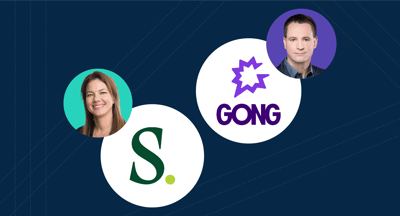August 11, 2025
 by Soundarya Jayaraman / August 11, 2025
by Soundarya Jayaraman / August 11, 2025

You’ve sent the emails. You’ve published the blogs. You’ve promoted the case studies. And sure, they get clicks. But they don’t exactly spark a 30-minute conversation with your ideal customer.
That’s where webinar marketing comes in. It’s one of the few channels where you can get undivided attention from a room full of decision-makers (and budget holders) for a solid chunk of time. There is no skimming, no scrolling, just real engagement with questions, objections, and lightbulb moments happening in real time.
Webinar marketing is the use of live or recorded online seminars to promote products, educate audiences, and generate leads. Businesses use webinars to engage potential customers, showcase expertise, and move prospects through the sales funnel.
As you help your audience reach this baseline goal via your webinar, you’ll also be preparing them to face the next step in their journey, which will require the use of your premium products or services to accomplish. Since you’ll have already proven your worth to these prospects, they’ll be much more likely to take you up on your premium offer.
Marketers often use webinar software like Cisco Webex, Zoom, or GoToWebinar that manages registration, reminders, interactive features, and post-event analytics so your team can focus on content and conversion.
In this guide, we’ll show B2B marketing and demand gen teams exactly how to plan, promote, and deliver webinars that don’t just fill the funnel but create sales-ready opportunities and accelerate deals.
Getting leads is easy. Getting the right leads, the decision-makers, influencers, and buying committee members who understand your solution is the real challenge. That’s where webinars stand out.
A 45-minute live session lets you:
Unlike ads or blog posts, webinars are a two-way conversation, not a one-way message.
With the right webinar software, you can:
Webinars aren’t just top-of-funnel content. They can:
Webinars give B2B teams the rare ability to engage, qualify, and convert high-value leads, often in a single event.
You already know webinars can capture attention, build trust, and move prospects closer to a buying decision, but not every webinar will achieve the same result. The format you choose can make or break the outcome.
Here’s a quick overview of the most effective B2B webinar formats and when to use them.
| Type of webinar | What it is | Best for |
| Product demos | Live walkthroughs showing exactly how your solution works, with real use cases and feature highlights. | Prospects evaluating your product and needing to see it in action. |
| Thought leadership panels | Expert-led discussions exploring industry trends, insights, or challenges, often featuring multiple speakers. | Building credibility and sparking interest among top-of-funnel audiences. |
| Customer success stories | Webinars where existing customers share their experiences, results, and ROI achieved with your solution. | Late-stage prospects who need social proof and outcome validation. |
| Workshops or training | Hands-on sessions that teach a process, skill, or strategy, often with downloadable tools or templates. | Audiences seeking value-first education that positions your solution naturally. |
Now, let’s look at each type in detail so you know exactly when and how to run them for maximum impact.
A product demo webinar is your chance to show, not just tell. Attendees see your solution in action, navigating the interface, exploring features, and understanding how it solves their problem. These work best when prospects are already considering your product and need to see proof that it delivers.
For example, G2’s quarterly innovation event webinars like “Reimagine an AI-First Review Experience” and its on-demand sessions like "Turn your G2 profile into a demand drive" showcase G2's capabilities in context, helping prospects visualize how features impact their day-to-day workflows.
Thought leadership webinars position your brand as a trusted voice in the industry. By bringing together internal experts, partners, or influencers, you can share timely insights and spark conversations on pressing challenges. They’re especially effective at the top of the funnel, where the goal is to build credibility and attract a wide audience.
For example, G2’s “Earning Trust in the AI Era: What Content & Sales Pros Must Do Differently” tackled one of the biggest shifts in sales and marketing today and showed how G2 is a strategic resource for both sales and marketing leaders navigating the change.
Workshops flip the focus to education. Rather than pitching, you’re teaching attendees a process or strategy they can implement right away. These are especially valuable mid-funnel, when buyers are actively searching for solutions to a specific problem. Done well, workshops position your brand as a helpful resource and naturally highlight how your solution makes the strategy easier to execute.
For example, AirOps runs a series in which SEO experts unpack common challenges and then show how the AirOps platform helps solve them. This format delivers immediate value while naturally positioning the tool as the go-to solution.
Customer success webinars let prospects hear results directly from their peers. Instead of your team making the case, your customers do it for you, sharing how they solved challenges and what measurable ROI they achieved. This format is most powerful in the late stages of the buying cycle, when prospects need validation before making a decision.
G2's the reviews & revenue connection series of resources, including a webinar, shows how customer feedback translates into tangible revenue impact, turning peer proof into a persuasive sales drive.
Now, webinar marketing isn’t about running one-off events. You cannot say "we'll do a workshop this quarter" and leave it at that. It’s about building a repeatable, scalable system that aligns with your broader demand generation efforts.
That means choosing the right type of webinar, mapping it to the right stage of the buyer journey, and executing with a strategy that goes beyond just the live event. Here's how you can do it:
Every successful webinar begins with clarity on what you want to achieve. Are you trying to generate net-new leads, accelerate opportunities already in the pipeline, or educate customers to reduce churn?
The clearer your goal, the easier it is to choose the right format, set the right KPIs (registrations, SQLs, influenced pipeline), and design content that resonates.
Once your goal is set, create a repeatable framework so every webinar feels intentional, not ad hoc. A good framework includes:
A webinar lives or dies by its topic. If it doesn’t speak to a real need or pain point, even the best promotion won’t get decision-makers to show up. Here are proven ways to uncover topics that resonate:
Even the best content won’t matter if no one shows up. Promotion should start 2–3 weeks before the event and run across multiple channels. Key tactics include:
The live event is where all the prep pays off. Beyond strong content, focus on creating an engaging attendee experience. The way you run the webinar should reflect your marketing and sales objectives, not just generic presentation best practices. Some specific approaches to consider:
A webinar isn’t over when the broadcast ends. The most successful teams treat the webinar as a content engine. Post-event campaigns should include:
A webinar’s value isn’t defined by how many people registered — it’s defined by how it moves the needle on the pipeline. To optimize your strategy, focus on metrics that connect directly to lead quality and sales outcomes:
Refinement comes from patterns, not one-offs. After each webinar, compare performance across formats, topics, and promotion channels. Maybe thought leadership panels drive the most registrations, but customer success stories convert the fastest. Or maybe LinkedIn ads outperform email for top-of-funnel attendance. Document these patterns and double down on what’s working, while cutting out tactics that don’t deliver pipeline impact.
Before we wrap up, let’s go over some universal best practices to follow as you create your next webinar marketing campaign.
The tools you use to develop and present your webinar can essentially dictate how the event plays out in full – and how your efforts impact your business. S, it’s critical that you choose the ones that are best for your purposes and circumstances.
In terms of the actual webinar software, your tool of choice should:
Some key features to look for here include:
It’s also important to ensure your webinar software integrates with the various other tools in your tech stack. This will allow your team to streamline your creative processes and keep everyone on the same page moving forward.
On that note, you certainly want to use these other tools to supercharge your webinar marketing initiatives. Your tools for communication, visual collaboration, knowledge management and more should all play a role in your webinar-related efforts.
Finally, don’t skimp on technical hardware. At the very least, you should invest in a quality headset, microphone, and camera. As you gain experience creating webinars, you might then dive into more advanced equipment, such as green screens, lighting, and a dedicated recording space.
Read that subhead again. Knowledge and charisma. It’s a package deal when it comes to your webinar host.
The best webinars balance expertise with delivery. A subject matter expert adds authority, but charisma keeps people engaged. Pair internal thought leaders with skilled moderators who know how to manage flow, encourage interaction, and keep energy high throughout the session.
Timing is everything in marketing, and marketing via webinar is no different. For one thing, you need to know when the optimal time to present your webinar is.
Promote your webinar at least two weeks in advance with a multi-channel approach (email, social, partner networks). Send reminder emails at 1 week, 1 day, and 1 hour before. For live sessions, data shows mid-week mornings (Tuesday–Thursday) often see the highest attendance for B2B audiences, but always check your own engagement data.
Still, don’t over-promote the event ad nauseam to your audience. If they get sick of hearing about your upcoming webinar, even those who are interested in attending might think twice about doing so.
Because you’ll be presenting your webinar to a live audience, there’s zero room for error.
You’ll want to do a dry run of the event from beginning to end to ensure everything goes according to plan. There are a number of things to pay attention to as you go through this dry run.
Don’t just test slides; do a complete dry run with all speakers, the moderator, and support staff. This ensures everyone knows their role, transitions are smooth, and tech hiccups are caught early. Use the rehearsal to time the session and cut or refine content if it drags..
This practice run-through should be an exact replica of what you hope your live event to be. As tempting as it will be to gloss over parts of the process that seem straightforward, an overlooked problem during your dry run will lead to major problems during the real thing.
Once you’ve presented your webinar in full, your focus should shift toward assessing the impact of the overall campaign.
Don’t just count registrations; analyze engagement spikes and drop-offs to understand what content resonated. Did a customer story spark more chat activity? Did attendees tune out during a feature dump? Feed those insights back into your content calendar, future webinar planning, and even sales messaging.
The overall goal, of course, is to make laser-focused improvements to all areas of your webinar marketing processes.
A few examples of improvements to be made:
To be clear, there will always be something to improve during your next webinar campaign. By taking an objective and comprehensive look at how your past events went, you’ll always know where to focus your energy moving forward.
Even seasoned marketers stumble when it comes to webinars. Some mistakes don’t just lower attendance. They can undercut credibility and waste valuable sales opportunities. Here are the pitfalls you’ll want to sidestep.
Too many webinars are thinly veiled product pitches. If your subject doesn’t connect with a real pain point, your target audience won’t register, or worse, they’ll leave halfway through. Always start by identifying what challenges your buyers are actively researching, then frame the session around solving those problems.
A thought leadership panel delivered to late-stage buyers can feel too broad. A feature-heavy demo offered to a cold audience can fall flat. Align each webinar format to where your audience is in the funnel. A mismatch wastes everyone’s time and creates friction instead of momentum.
Marketers often try to cover too much in one webinar: five features, four customer stories, three trends. Attendees leave overwhelmed and unclear on the core takeaway. Keep the scope tight, deliver one or two big insights, and make those memorable.
Many teams hit “end broadcast” and move on. But most of your audience will consume webinars after the live event. If you’re not editing, packaging, and actively promoting the on-demand version, you’re losing half the value of your effort.
Even great content falls apart if your platform doesn’t support the experience you want to deliver. Using the wrong tool for the wrong format, like a basic video tool for an interactive workshop, creates a poor attendee experience.
Your software should scale with your goals, whether that’s hosting a 1,000-person thought leadership event or running a small, interactive workshop. Here are the top 5 webinar software on G2, each with a different strength:
Comparing verified reviews in G2’s webinar software category can help you find the best fit for your business needs.
Have more questions? G2 has the answers.
Yes. Webinars remain one of the most effective B2B marketing tactics in 2025 because they deliver depth, interactivity, and trust-building that short-form content can’t match. They also scale easily through on-demand recordings.
Promote your webinar with a mix of email campaigns, social media posts, paid ads, and partner co-marketing. Always create a dedicated landing page, and send reminders to boost live attendance.
They can be highly profitable when aligned with sales goals. Webinars generate qualified leads, accelerate the pipeline, and offer evergreen content that continues to drive ROI long after the live event.
Start with a strong topic, pick the right format, and rehearse thoroughly. Use engaging speakers, plan interactivity (polls, Q&A), and ensure follow-up campaigns to convert attendees into customers.
The best tool depends on your needs. Platforms like Webex are ideal for large enterprises, Livestorm for ease of use, Zoho Webinar for SMBs, ON24 for analytics, and Microsoft Teams for organizations already on Microsoft 365.
For B2B audiences, midweek (Tuesday–Thursday) mornings or early afternoons generally perform best. But always test and analyze your own audience engagement data for optimal timing.
Webinars aren’t just another content format. They’re one of the rare opportunities to hold your audience’s full attention and guide them closer to a decision in real time. The companies that win with webinars aren’t the ones chasing registrations, but the ones designing every event to educate, engage, and qualify the right prospects.
Think of webinars less as “events” and more as pipeline engines. From the topic you choose to the software you run it on, every decision should ladder up to one question: Will this help my buyers take their next step with confidence? Nail that, and your webinar marketing won’t just fill seats, it’ll fuel your growth.
Ready to take your campaigns further? Explore marketing automation software on G2 to scale your webinar follow-ups and nurture every lead with precision.
This article was published in 2020 and has been updated with new information.
Soundarya Jayaraman is a Content Marketing Specialist at G2, focusing on cybersecurity. Formerly a reporter, Soundarya now covers the evolving cybersecurity landscape, how it affects businesses and individuals, and how technology can help. You can find her extensive writings on cloud security and zero-day attacks. When not writing, you can find her painting or reading.
Over the years, I’ve collaborated with marketing teams to produce various webinars, from live...
 by Sudipto Paul
by Sudipto Paul
Whether you're speaking to a live audience of 10 or 10,000 or delivering a talk online,...
 by Daniella Alscher
by Daniella Alscher
We recently had the pleasure of hosting our CMO Consult Webinar, where I was joined by Udi...
 by Amanda Malko
by Amanda Malko
Over the years, I’ve collaborated with marketing teams to produce various webinars, from live...
 by Sudipto Paul
by Sudipto Paul
Whether you're speaking to a live audience of 10 or 10,000 or delivering a talk online,...
 by Daniella Alscher
by Daniella Alscher


